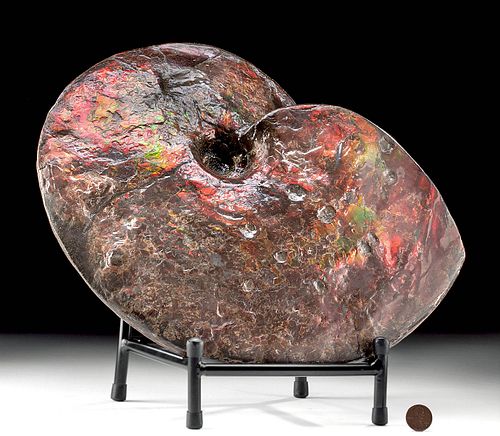Very Rare Huge Opal Ammolite, Bitten by Mosasaur
Lot 109
About Seller
Artemis Fine Arts
686 S Taylor Ave, Ste 106
Louisville, CO 80027
United States
Selling antiquities, ancient and ethnographic art online since 1993, Artemis Gallery specializes in Classical Antiquities (Egyptian, Greek, Roman, Near Eastern), Asian, Pre-Columbian, African / Tribal / Oceanographic art. Our extensive inventory includes pottery, stone, metal, wood, glass and textil...Read more
Categories
Estimate:
$8,000 - $12,000
Absentee vs Live bid
Two ways to bid:
- Leave a max absentee bid and the platform will bid on your behalf up to your maximum bid during the live auction.
- Bid live during the auction and your bids will be submitted real-time to the auctioneer.
Bid Increments
| Price | Bid Increment |
|---|---|
| $0 | $25 |
| $300 | $50 |
| $1,000 | $100 |
| $2,000 | $250 |
| $5,000 | $500 |
| $10,000 | $1,000 |
| $20,000 | $2,500 |
| $50,000 | $5,000 |
| $100,000 | $10,000 |
| $200,000 | $20,000 |
About Auction
By Artemis Fine Arts
Oct 8, 2020
Set Reminder
2020-10-08 10:00:00
2020-10-08 10:00:00
America/New_York
Bidsquare
Bidsquare : Exceptional Antiquities, Asian, Ethnographic
https://www.bidsquare.com/auctions/artemis-gallery/exceptional-antiquities-asian-ethnographic-5796
Museum-worthy examples of Egyptian, Greek, Roman, Etruscan, Near Eastern, Far East / Asian, Pre-Columbian, African / Tribal,Oceanic, Native American, Spanish Colonial, Russian, Fossils, Ancient Jewelry, Fine Art, so much more! Artemis Fine Arts info@artemisfinearts.com
Museum-worthy examples of Egyptian, Greek, Roman, Etruscan, Near Eastern, Far East / Asian, Pre-Columbian, African / Tribal,Oceanic, Native American, Spanish Colonial, Russian, Fossils, Ancient Jewelry, Fine Art, so much more! Artemis Fine Arts info@artemisfinearts.com
- Lot Description
North America, Alberta, Canada, upper-Cretaceous period, 70 to 75 million years ago. A huge ammolite - a fossilized shell of an extinct sea creature known as an ammonite, that is only found in the Bearpaw Formation of Alberta, Canada. This is an organic gemstone that boasts an astonishing array of iridescent colors. The brightness of this specimen's colors and the iridescence is a testament to the well-preserved state of the nacreous shell, and how orderly and fine the aragonite layers are. Please note that this fossil shows tooth marks from a Mosasaur, a large extinct marine reptile predator that was apparently hungry for an ammonite. Holes like these were once thought to result from limpets attaching themselves to the ammonites; however, their size as well as presence on both sides of the ammonite, linked them to the upper and lower jaws and the bite of medium-sized Mosasaurs. Size: 12.75" W x 10.875" H (32.4 cm x 27.6 cm); 10.25" H (26 cm) on included custom stand (piece leans back on the stand).
Ammolite is a rare, iridescent, gem-quality material cut from the fossilized shells of extinct sea creatures known as ammonites. Found only in the Bearpaw Formation in Alberta, Canada - along the eastern slopes of the Rocky Mountains, this organic gemstone has a dazzling range of colors and patterns and is highly desired for freeform natural cabochons and assembled jewelry pieces.
According to the International Gem Society (IGS) statement on the difference between Ammolite and Ammonite: "You may find the terms ammolite and ammonite sometimes used interchangeably. However, ammonite, strictly speaking, refers to the fossil shells of ammonites, whether gem-quality or not. Ammolite refers to the gem-quality material made from fossils of particular species of ammonites." Also according to IGS, "Ammonites were marine mollusks that became extinct around 65 million years ago. There were many species of ammonites, and their fossils have been found across the globe. The fossils of Placenticeras meeki, Placenticeras intercalare, and Baculites compressus can yield gem-quality ammolite. To date, this material has been found only in Alberta, Canada."
The etymology of Ammonite according to International Gem Society: "From ammonite, the fossils of an extinct cephalopod with a spiral shell like a ram's horn. Ammonite was named after the Ancient Egyptian god Amun, who was represented with ram's horns."
Accompanying label states, "Ammolite Bitten by Mosasaur / 71 million years old / Bear Paw Formation, Blood Indian Reserve, St. Mary River, Alberta Canada - Beautiful Canadian Gemstone"
Provenance: ex-private Saint Louis, MO, USA collection
All items legal to buy/sell under U.S. Statute covering cultural patrimony Code 2600, CHAPTER 14, and are guaranteed to be as described or your money back.
A Certificate of Authenticity will accompany all winning bids.
We ship worldwide and handle all shipping in-house for your convenience.
#159348Presents with a lovely array of iridescent hues: in various shades of red, yellow, and green. Very nice chromatic shift. Cracking and Mososaur bite marks to surface as shown.Condition
- Shipping Info
-
All shipping is handled in-house for your convenience. Your invoice from Artemis Gallery will include shipping calculation instructions. If in doubt, please inquire BEFORE bidding for estimated shipping costs for individual items.
-
- Buyer's Premium



 EUR
EUR CAD
CAD AUD
AUD GBP
GBP MXN
MXN HKD
HKD CNY
CNY MYR
MYR SEK
SEK SGD
SGD CHF
CHF THB
THB














